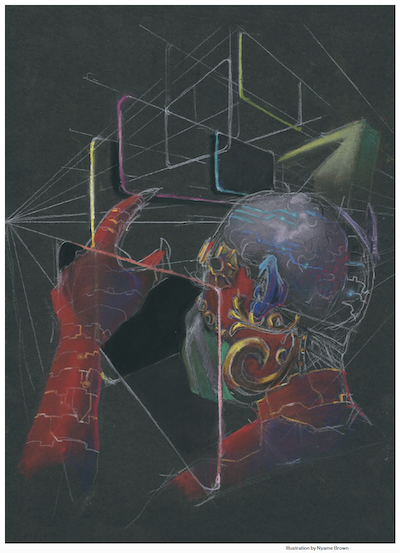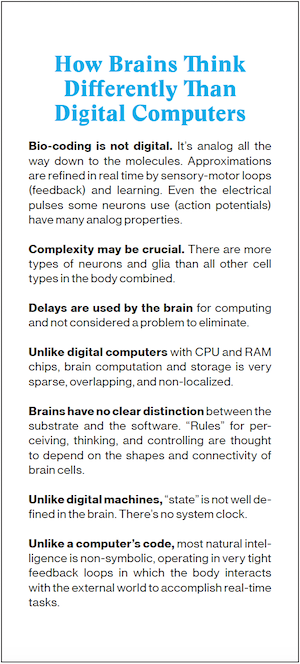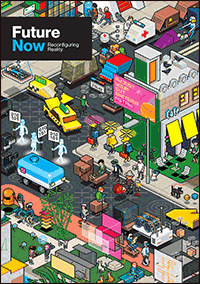Future Now
The IFTF Blog
Wetware-Hardware Hybrids
The future of computing and neural interfacing
Written by Steve M. Potter, PhD for volume three of Future Now,
IFTF's print magazine powered by our Future 50 Partnership.
The Coming Wetware Revolution
All life as we know it is made of cells that are squishy and full of salt water. That’s why animals’ control systems (networks of neurons and glial cells) are sometimes referred to as “wetware”—the basis of all natural intelligence (NI). Digital computers, by contrast, are dry and crunchy: hardware is the substrate on which today’s artificial intelligence (AI) runs. Wetware operates (to the limited extent we understand it) under very different rules than digital hardware (see sidebar). I am excited about the possibilities for hardware-enhanced cognition in people, as well as wetware-enhanced processing in computers. The inevitable path to this hybrid neural-synthetic future will be paved with better brain understanding, better neural interfaces, and computers that do a better job emulating brain function in software or in specialized neuromorphic (brain-inspired) hardware. Deep learning is one example of applying neuroscience inspiration to computing at the software level. By taking it to the next level, where not only software, but also hardware and wetware all take inspiration from human brains, we will enjoy astonishing transformations in computing.
 To date, neither AI nor NI has really benefitted from wetware-hardware hybrid systems. Why not? Because living neural systems are complex and hard to understand, let alone reverse-engineer. Neural interfacing is technically challenging. That said, I am confident that hybrid wetware-hardware intelligent things will someday be as common and as useful as digital computers are today. Unlike with quantum computing, we have many examples of working devices that do amazing brain-style computing: brains! Even a fly brain is more powerful and efficient than the best digital flight controllers humans have designed. How do brains accomplish such amazing feats of real-time sensor processing and control of precise movements? Where do they get their creativity and inventiveness? There is strong motivation to discover enough of the brain’s secrets to create new forms of hybrid AI that make the most of digital and brain-style computing.
To date, neither AI nor NI has really benefitted from wetware-hardware hybrid systems. Why not? Because living neural systems are complex and hard to understand, let alone reverse-engineer. Neural interfacing is technically challenging. That said, I am confident that hybrid wetware-hardware intelligent things will someday be as common and as useful as digital computers are today. Unlike with quantum computing, we have many examples of working devices that do amazing brain-style computing: brains! Even a fly brain is more powerful and efficient than the best digital flight controllers humans have designed. How do brains accomplish such amazing feats of real-time sensor processing and control of precise movements? Where do they get their creativity and inventiveness? There is strong motivation to discover enough of the brain’s secrets to create new forms of hybrid AI that make the most of digital and brain-style computing.
Neuroscience Needs to Mind-meld with Computer Science
It’s a bit shocking how poorly we understand the brain, considering how important it is in our lives. Neurobiologists don’t really understand what a thought is, where feelings come from, how memories are stored, or how we learn. We are at a stage equivalent to the Victorian understanding of the sun: it is likely there are concepts of brain function we can’t conceive of yet, in the same way nuclear fusion would boggle an 18th century scientist. There is cause for optimism: the plodding pace of academic neuro-research is being spurred on by funding from the Brain Research through Advancing Innovative Neurotechnologies (BRAIN) Initiative created by the Obama administration, and the EU’s Human Brain Project. New non-profit and corporate think tanks have decided to make the understanding of NI their primary goal. These include Paul Allen’s Allen Institute for Brain Science, Elon Musk’s Neuralink, Bryan Johnson’s Kernel, and Google’s Brain Team. Transformational advances will happen when these efforts merge with those dedicated to building better AI systems, such as OpenAI, Google’s Deep Mind, IBM’s Watson, and related AI projects at Facebook, Amazon, Microsoft, Baidu, etc.
But incomplete understanding of the nervous system and NI is no excuse for holding back on implementing some version of what we do know in artificial systems. The nervous system’s immense complexity may be important in providing NI’s powerful capabilities. However, the capabilities of neurally-inspired deep learning systems show that we can accomplish many useful AI tasks by emulating only a small bit of that complexity. Advances in neuromorphic software and hardware may supersede the use of actual living tissue to compute, in the same way that jet planes superseded the need to build flapping wings to make things that fly fast.
The Future of Neural Interfacing is Optical
Researchers use neural interfaces to study and influence the nervous system in people, in animals, and in vitro. Neural interfaces come in two types: augmented humans and augmented computers. Humans augmented with neural interfacing technology accomplish miracles on a daily basis: the deaf use cochlear implants to hear, people with paraplegia use spinal cord stimulators to walk, and those with pains and tremors use deep brain stimulators to quell their suffering.
But the second type of neural interface—computers augmented with living neurons—is still a laboratory curiosity. Since 1999, my labs at Caltech and at Georgia Tech University have been developing open-source neural interfacing technology, including NeuroRighter. Our closed-loop neural interfaces use electrical and optical stimulation to train brain tissue growing in a petri dish (e.g., to control robots and simulated animals to accomplish simple navigation tasks). This was a humble but crucial first step in making useful hybrid computing systems. We published that work nearly a decade ago, yet hardware that incorporates wetware (living neurons) has not advanced much since then. Present day electrical neural interfaces are rudimentary. They lack the feedback that is ubiquitous in nervous systems and use only a few electrodes with limited bandwidth. Brain stimulators, sensory prostheses, and robotic prosthetic limbs will be much smarter when they continuously monitor and fine-tune their own functioning and when they can talk to many brain cells.
 Optogenetics is a fast-advancing neural interfacing technology that enables the control and monitoring of brain cells with light. Genes from various light-sensitive algae and bacteria are added to the neurons’ collection of genes using viral vectors, making the neurons light-sensitive. This type of gene therapy has proven to be effective in lab animals to allow neural control and readout with fiber optics and LEDs. This is great news for neural interfacing, because fiber optics are not as prone to failure and rejection by the body as are microelectrodes. Fiber optics and optogenetics enable high-bandwidth two-way interfaces in which specific cell types can be addressed with different colors of light. In my lab, we used optogenetics to induce homeostatic plasticity, a type of slow learning or adaptation, in cortical tissue in vitro. Using NeuroRighter’s closed-loop optical stimulator, in vitro brain tissue dialed up its own firing with blue light, or quieted itself with yellow light to induce enduring changes in its activity. This opens the door for all sorts of smart brain modulation therapies that make use of feedback (e.g., for calming down seizure-prone neural circuits or eliminating chronic pain). Neural interfaces of the future will be bidirectional, high-bandwidth optical interfaces with fast feedback loops. This will allow hardware and wetware to cooperate as a unified synergistic hybrid system that takes advantage of the brain’s plasticity and learning mechanisms.
Optogenetics is a fast-advancing neural interfacing technology that enables the control and monitoring of brain cells with light. Genes from various light-sensitive algae and bacteria are added to the neurons’ collection of genes using viral vectors, making the neurons light-sensitive. This type of gene therapy has proven to be effective in lab animals to allow neural control and readout with fiber optics and LEDs. This is great news for neural interfacing, because fiber optics are not as prone to failure and rejection by the body as are microelectrodes. Fiber optics and optogenetics enable high-bandwidth two-way interfaces in which specific cell types can be addressed with different colors of light. In my lab, we used optogenetics to induce homeostatic plasticity, a type of slow learning or adaptation, in cortical tissue in vitro. Using NeuroRighter’s closed-loop optical stimulator, in vitro brain tissue dialed up its own firing with blue light, or quieted itself with yellow light to induce enduring changes in its activity. This opens the door for all sorts of smart brain modulation therapies that make use of feedback (e.g., for calming down seizure-prone neural circuits or eliminating chronic pain). Neural interfaces of the future will be bidirectional, high-bandwidth optical interfaces with fast feedback loops. This will allow hardware and wetware to cooperate as a unified synergistic hybrid system that takes advantage of the brain’s plasticity and learning mechanisms.
Cognitive Prostheses?
It will take intensive research and development to go from our current rudimentary electrical neural interfaces (such as deep brain stimulators and cochlear implants) to smart optical hybrid systems that are implanted in everyone to enhance their cognition. Efforts to make a “cognitive prosthesis” to replace lost function are just beginning to show promise in lab animals. For example, optogenetics was used by neurobiologists at MIT to restore the recall of forgotten memories in a mouse model of Alzheimer’s disease. Presently, however, most of the hardware and all of the software interacting with the lab animals’ wetware is outside the animal on large racks. Neuroengineers continue to develop miniature biocompatible devices for implanting into the brain. That said, I believe that non-invasive brain interfaces that exploit high-bandwidth communication via our eyes, ears, and skin (such as EEG and virtual reality) are poised to show the most impressive cognitive augmentation for at least the next few decades.
Outlook
Neural interfaces will get more sophisticated and will be used to augment computers and humans, not just to treat medical problems. Bio-inspired AI will provide many new capabilities, first by emulating the brain’s feedback systems, and then by actually using brain tissue to compute in hybrid semi-living systems. The computers of tomorrow will be created by a new breed of cross-disciplinary engineer-scientists who are experts not only in machine-learning, but also in neurobiology.
 FUTURE NOW—Reconfiguring Reality
FUTURE NOW—Reconfiguring Reality
This third volume of Future Now, IFTF's print magazine powered by our Future 50 Partnership, is a maker's guide to the Internet of Actions. Use this issue with its companion map and card game to anticipate possibilities, create opportunities, ward off challenges, and begin acting to reconfigure reality today.
About IFTF's Future 50 Partnership
Every successful strategy begins with an insight about the future and every organization needs the capacity to anticipate the future. The Future 50 is a side-by-side relationship with Institute for the Future: a partnership focused on strategic foresight on a ten-year time horizon. With 50 years of futures research in society, technology, health, the economy, and the environment, we have the perspectives, signals, and tools to make sense of the emerging future.
For More Information
For more information on IFTF's Future 50 Partnership and Tech Futures Lab, contact:
Sean Ness | sness@iftf.org | 650.233.9517



